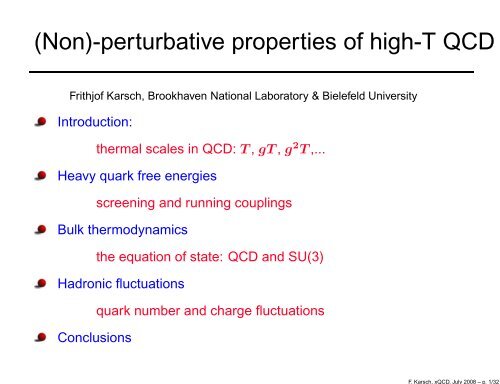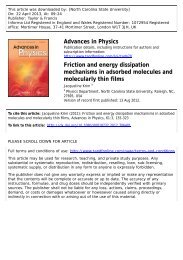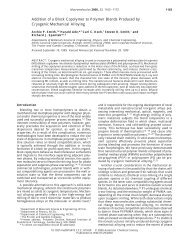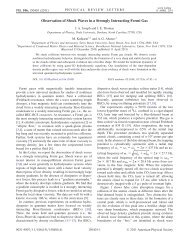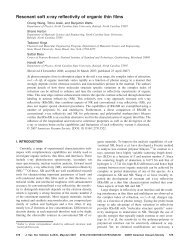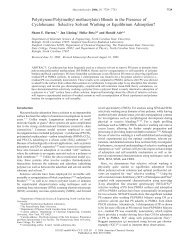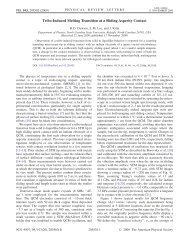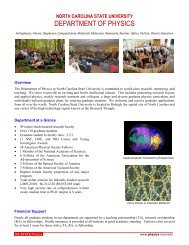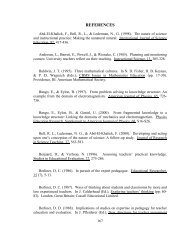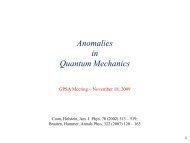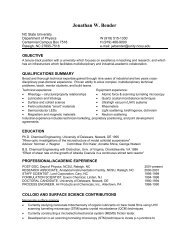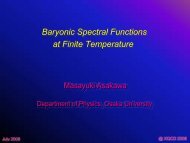(Non)-perturbative properties of high-T QCD from lattice ... - Physics
(Non)-perturbative properties of high-T QCD from lattice ... - Physics
(Non)-perturbative properties of high-T QCD from lattice ... - Physics
Create successful ePaper yourself
Turn your PDF publications into a flip-book with our unique Google optimized e-Paper software.
F. Karsch, x<strong>QCD</strong>, July 2008 – p. 1/32(<strong>Non</strong>)-<strong>perturbative</strong> <strong>properties</strong> <strong>of</strong> <strong>high</strong>-T <strong>QCD</strong>Frithj<strong>of</strong> Karsch, Brookhaven National Laboratory & Bielefeld UniversityIntroduction:thermal scales in <strong>QCD</strong>: T , gT , g 2 T ,...Heavy quark free energiesscreening and running couplingsBulk thermodynamicsthe equation <strong>of</strong> state: <strong>QCD</strong> and SU(3)Hadronic fluctuationsquark number and charge fluctuationsConclusions
F. Karsch, x<strong>QCD</strong>, July 2008 – p. 2/32Introduction: sQGPmatter created at RHIC is a dense, strongly interacting systemDoes the coupling at finite temperature become large?Are exotic bound states in the QGP responsible for largeinteraction cross sections?Is the QGP a liquid?Can the QGP be described in terms <strong>of</strong> a conformal field theory?overview on <strong>perturbative</strong> and non-<strong>perturbative</strong> features <strong>of</strong> the QGP
Thermal scales in <strong>QCD</strong>the hard scale: p ∼ Tthermal modes, bulk thermodynamics, eg. pressurepT 4 = a SBf p (g(T))the s<strong>of</strong>t scale: p ∼ gTstatic color-electric modes, eg. Debye screening√m D (T)g(T)T = N c3 + n f6 + n ( ) 2f µq· f2π 2 E (g(T))Tthe ultra-s<strong>of</strong>t scale: p ∼ g 2 Tstatic color-magnetic modes, eg. spatial string tension√σsg 2 (T)T = c Mf M (g(T))F. Karsch, x<strong>QCD</strong>, July 2008 – p. 3/32
F. Karsch, x<strong>QCD</strong>, July 2008 – p. 5/32Hierachy <strong>of</strong> scale ?Perturbation theory provides a hierachy <strong>of</strong> length scalesT ≫ gT ≫ g 2 T ...⇒ guiding principle for effective theories,resummation, dimensional reduction...These scales are not well separated close to T c !!Early <strong>lattice</strong> results show that g 2 (T) > 1 even at T ∼ 5T cG. Boyd et al, NP B469 (1996) 419: SU(3) thermodynamics.....one has to conclude that the temperature dependent runningcoupling has to be large, g 2 (T) ≃ 2 even at T ≃ 5T cthe Debye screening mass is large close to T cthe spatial string tension does not vanish above T c√σs ≠ 0 ⇒ the QGP is ”non-<strong>perturbative</strong>” up to very <strong>high</strong> T
Screening <strong>of</strong> heavy quark free energies– remnant <strong>of</strong> confinement above T c –pure gauge: O.Kaczmarek, FK, P. Petreczky, F. Zantow, PRD70 (2005) 0745052-flavor <strong>QCD</strong>: O.Kaczmarek, F. Zantow, Phys. Rev. D71 (2005) 114510singlet free energy(in Coulomb gauge)1000T ≃ T c : screening forr> ∼0.5fmF 1 (r, T) ∼ α(T)r+const.500e −µ(T)r0-500F 1 [MeV]r [fm]0.76T c0.81T c0.90T c0.96T c1.00T c1.02T c1.07T c1.23T c1.50T c1.98T c4.01T c0 0.5 1 1.5 2 2.5 34α(r, T = 0)F 1 (r, T) follows linear rise <strong>of</strong> V¯qq (r, T = 0) = −3rfor T< ∼1.5T c , r< ∼0.3 fm+ σrF. Karsch, x<strong>QCD</strong>, July 2008 – p. 6/32
<strong>Non</strong>-<strong>perturbative</strong> Debye screeningleading order perturbation theory: m D = g D (T)T√1 + n f6T c < T< ∼10T c : non-<strong>perturbative</strong> effects are well representedby an ”A-factor”: m D ≡ Ag D (T)T, A ≃ 1.5<strong>perturbative</strong> limit is reached very slowly4.0(logarithms at work!!)SU(3)10 100 β G=144 32 310 10T/Λ MS1010.543m D /Tm D /T=Ag(T)A=1.42(2)N f =0N f =23.02.0m/gT210T/T c1 1.5 2 2.5 3 3.5 41.00.0xβ G=72 24 3β G=40 24 3β G=24 24 3β G=12 24 310 −3 10 −2 10 −1O.Kaczmarek,F.Zantow, PRD 71 (2005) 114510 K.Kajantie et al, PRL 79 (1997) 3130F. Karsch, x<strong>QCD</strong>, July 2008 – p. 7/32
<strong>Non</strong>-<strong>perturbative</strong> Debye screeningleading order perturbation theory: m D = g D (T)T√1 + n f6T c < T< ∼10T c : non-<strong>perturbative</strong> effects are well representedby an ”A-factor”: m D ≡ Ag D (T)T, A ≃ 1.5<strong>perturbative</strong> limit is reached very slowly4.0(logarithms at work!!)SU(3)10 100 β G=144 32 310 10T/Λ MS1010.543m D /Tm D /T=Ag(T)A=1.42(2)N f =0N f =23.02.0m/gT210g 2 D (T c) ≃ 4 , g 2 D (4T c) ≃ 2T/T c1 1.5 2 2.5 3 3.5 41.00.0xβ G=72 24 3β G=40 24 3β G=24 24 3β G=12 24 310 −3 10 −2 10 −1O.Kaczmarek,F.Zantow, PRD 71 (2005) 114510 K.Kajantie et al, PRL 79 (1997) 3130F. Karsch, x<strong>QCD</strong>, July 2008 – p. 7/32
<strong>Non</strong>-<strong>perturbative</strong> Debye screeningµ q -dependence43.532.521.510.50leading order perturbation√theory:m D = g(T)T1 + n f6 + n (f µq2π 2 TTaylor expansion, 2-flavor <strong>QCD</strong>:( ) 2 µqm D (T) = m 0 (T) + m 2 (T) + O(µ 4 qT)m 2 /m 0 = 3/8π 2 : agrees with perturbation theory for T> ∼1.5T cm 1 0 /T 21.510.50T/T c1 1.5 2 2.5 3 3.5 4M. Döring et al., Eur. Phys. J. C46 (2006) 179) 2m 1 2 /T1/2 ⋅ m av2 /TT/T c1 1.5 2 2.5 3 3.5 4F. Karsch, x<strong>QCD</strong>, July 2008 – p. 8/32
<strong>Non</strong>-<strong>perturbative</strong> Debye screeningµ q -dependence43.532.521.510.50leading order perturbation√theory:m D = g(T)T1 + n f6 + n (f µq2π 2 Tm 1 0 /T 21.510.50T/T c1 1.5 2 2.5 3 3.5 4M. Döring et al., Eur. Phys. J. C46 (2006) 179) 2non-<strong>perturbative</strong>effects are in the gluequark sectorTaylor expansion, 2-flavor <strong>QCD</strong>:( ) ”<strong>perturbative</strong>”2µqm D (T) = m 0 (T) + m 2 (T) + O(µ 4 qT) above T> ∼1.5T c ?m 2 /m 0 = 3/8π 2 : agrees with perturbation theory for T> ∼1.5T cm 1 2 /T1/2 ⋅ m av2 /TT/T c1 1.5 2 2.5 3 3.5 4F. Karsch, x<strong>QCD</strong>, July 2008 – p. 8/32
The spatial string tensionDoes dimensional reduction work with light quarks?<strong>Non</strong>-<strong>perturbative</strong>, vanishes in <strong>high</strong>-T perturbation theory:√σs = −lim ln W(R x, R y )R x ,R y →∞ R x R y1.2√σsg 2 σ (T)T = c σ , c σ ≡ c 3 , g 2 E ≡ g2 σ T_T c/ Λ MS= 1.10...1.35c 3 : 3-d SU(3), LGTg 2 σ : 2-loop dim. red. pert. th.1.02-loop4-d SU(3), LGT data:G. Boyd et al. Nucl. Phys. B469 (1996) 419T/σ s1/20.81-loop0.64d <strong>lattice</strong>, N τ1= 81.0 2.0 3.0 4.0 5.0T / T c3-d SU(3), dimensional reduction:M. Laine, Y. Schröder, JHEP 0503 (2005) 067F. Karsch, x<strong>QCD</strong>, July 2008 – p. 9/32
F. Karsch, x<strong>QCD</strong>, July 2008 – p. 9/32The spatial string tensionDoes dimensional reduction work with light quarks?<strong>Non</strong>-<strong>perturbative</strong>, vanishes in <strong>high</strong>-T perturbation theory:√σs = −lim ln W(R x, R y )R x ,R y →∞ R x R y√σsg 2 σ (T)T = c σ , c σ ≡ c 3 , g 2 E ≡ g2 σ T0.5 1 2c 3 : 3-d SU(3), LGTg 2 σ : 2-loop dim. red. pert. th.0.8r 0 Tg 2 σ(T c ) ≃ 3.7 , g 2 σ(5T c ) ≃ 20.70.60.50.41/2T/σ s (T)(2+1)-flavor <strong>QCD</strong>N τ =4N τ =6T/T 0 N τ =81 1.5 2 2.5 3 3.5 4 4.5 5dimensional reduction works for T> ∼2T c- c M (almost) flavor independent- g 2 σ(T) shows 2-loop runningc σ = 0.553(1) [SU(3)]c σ = 0.54(1) [<strong>QCD</strong>]M. Cheng et al (RBC-Bielefeld),arXiv:0806.3264
Screening <strong>of</strong> heavy quark free energies– remnant <strong>of</strong> confinement above T c –pure gauge: O.Kaczmarek, FK, P. Petreczky, F. Zantow, PRD70 (2005) 0745052-flavor <strong>QCD</strong>: O.Kaczmarek, F. Zantow, Phys. Rev. D71 (2005) 114510singlet free energy(in Coulomb gauge)1000T ≃ T c : screening forr> ∼0.5fmF 1 (r, T) ∼ α(T)r+const.500e −µ(T)r0-500F 1 [MeV]r [fm]0.76T c0.81T c0.90T c0.96T c1.00T c1.02T c1.07T c1.23T c1.50T c1.98T c4.01T c0 0.5 1 1.5 2 2.5 34α(r, T = 0)F 1 (r, T) follows linear rise <strong>of</strong> V¯qq (r, T = 0) = −3rfor T< ∼1.5T c , r< ∼0.3 fm+ σrF. Karsch, x<strong>QCD</strong>, July 2008 – p. 10/32
F. Karsch, x<strong>QCD</strong>, July 2008 – p. 11/32Singlet free energyand asymptotic freedompure gauge: O.Kaczmarek, FK, P. Petreczky, F. Zantow, PRD70 (2005) 0745052-flavor <strong>QCD</strong>: O.Kaczmarek, F. Zantow, Phys. Rev. D71 (2005) 114510singlet free energy defines a running coupling:α eff = 3r24dF 1 (r, T)dr(in Coulomb gauge)0.60.50.40.30.20.10α qq (r,T)r [fm]0.01 0.1T/T cT=01.051.101.201.301.501.603.006.009.0012.0
Singlet free energyand asymptotic freedompure gauge: O.Kaczmarek, FK, P. Petreczky, F. Zantow, PRD70 (2005) 0745052-flavor <strong>QCD</strong>: O.Kaczmarek, F. Zantow, Phys. Rev. D71 (2005) 114510singlet free energy defines a running coupling:α eff = 3r24dF 1 (r, T)dr(in Coulomb gauge)large distance: constantCoulomb term (string model)0.60.50.40.30.2short distance: running couplingα(r) <strong>from</strong> (T = 0), 3-loop0.1(S. Necco, R. Sommer,Nucl. Phys. B622 (2002) 328) 0111 000111 000111 000111 000111 000α qq (r,T)α ≡ π/16r [fm]0.01 0.1short distance physics ⇔ vacuum physics00 1100 1100 11000 111000 111000 111T/T cT=01.051.101.201.301.501.603.006.009.0012.0T-dependence starts in non-<strong>perturbative</strong>regime for T< ∼ 3 T cF. Karsch, x<strong>QCD</strong>, July 2008 – p. 11/32
Singlet free energyand asymptotic freedompure gauge: O.Kaczmarek, FK, P. Petreczky, F. Zantow, PRD70 (2005) 0745052-flavor <strong>QCD</strong>: O.Kaczmarek, F. Zantow, Phys. Rev. D71 (2005) 114510singlet free energy defines a running coupling:α eff = 3r24dF 1 (r, T)dr(in Coulomb gauge)large distance: constantCoulomb term (string model)0.60.50.40.300 1100 1100 11111 000111 000111 000111 000111 000α qq (r,T)rise due toconfinementT/T cT=01.051.101.201.301.501.603.006.009.0012.0α eff ∼ σr 2α ≡ π/16regime for T< ∼ 3 T cF. Karsch, x<strong>QCD</strong>, July 2008 – p. 11/320.2short distance: running couplingα(r) <strong>from</strong> (T = 0), 3-loop0.1(S. Necco, R. Sommer,r [fm]Nucl. Phys. B622 (2002) 328) 00.01 0.1T-dependence starts in non-<strong>perturbative</strong>short distance physics ⇔ vacuum physics00 1100 1100 11000 111000 111000 111
F. Karsch, x<strong>QCD</strong>, July 2008 – p. 12/32<strong>QCD</strong> equation <strong>of</strong> statetwo prominent features <strong>of</strong> EoS that characterize thenon-<strong>perturbative</strong> structure <strong>of</strong> <strong>QCD</strong> at <strong>high</strong> temperaturestrong deviations <strong>from</strong> ideal gas behavior (ǫ = 3p) forT c ≤ T< ∼3T cdeviations <strong>from</strong> Stefan-Boltzmann limit persist even at <strong>high</strong> T16.014.012.010.08.06.04.02.00.0ε SB /T 4strong deviations <strong>from</strong> ε = 3p (10-15)%dev.ε/T 4 3p/T 43 flavor, N τ =4, p4 staggeredm π =770 MeVT/T c1.0 1.5 2.0 2.5 3.0 3.5 4.0
F. Karsch, x<strong>QCD</strong>, July 2008 – p. 12/32<strong>QCD</strong> equation <strong>of</strong> statetwo prominent features <strong>of</strong> EoS that characterize thenon-<strong>perturbative</strong> structure <strong>of</strong> <strong>QCD</strong> at <strong>high</strong> temperaturestrong deviations <strong>from</strong> ideal gas behavior (ǫ = 3p) forT c ≤ T< ∼3T cdeviations <strong>from</strong> Stefan-Boltzmann limit persist even at <strong>high</strong> Tstructure <strong>of</strong> EoS is ’universal’, i.e. shows little quark massdependence in ǫ/ǫ SB vs. T/T cquark content changes only ’details’
F. Karsch, x<strong>QCD</strong>, July 2008 – p. 13/32SU(3) Equation <strong>of</strong> Statepressure: LGT vs. HTL<strong>high</strong> T part <strong>of</strong> the pressure calculated on the <strong>lattice</strong> is in good agreementwith HTL-resummed perturbation theory for T > ∼3T c1.81.61.41.2p/T 4HTL1.00.80.60.40.20.0(1x1)(1x2)RG(1x2) tadT/T c1.0 1.5 2.0 2.5 3.0 3.5 4.0 4.5HTL:J.P. Blaizot,E. Iancu, A. Rebhan,PL B470 (99) 181no need for AdS/<strong>QCD</strong> to explain ’pressure gap’
The pressure revisitedT> ∼(2-3)T c : deviations <strong>from</strong> ideal gas understood in terms <strong>of</strong>HTL-resummed perturbation theoryT< ∼2T c : strong deviations <strong>from</strong> ideal gasdeviations <strong>from</strong> p SB almost flavor independent54p/T 4 p SB /T 41.00.8p/p SB30.6213 flavour2+1 flavour2 flavourpure gauge0.40.23 flavour2 flavour2+1 flavourpure gauge0T [MeV]100 200 300 400 500 6000.0T/T c1.0 1.5 2.0 2.5 3.0 3.5 4.0FK, E. Laermann and A. Peikert, Phys. Lett. B478 (2000) 447F. Karsch, x<strong>QCD</strong>, July 2008 – p. 14/32
(2+1)-flavor <strong>QCD</strong>: ...towards the cont. limit (N τ = 8)with light quarks (m π ≃ 220 MeV)980.4 0.6 0.8 1.0 1.2Tr 04.54.00.8 1.0 1.2 1.4 1.6 1.8(ε-3p)/T 4Tr 07654(ε-3p)/T 4 asqtad: N τ =68p4: N τ =683.53.02.52.0p4: N τ =468asqtad: N τ =68321.51.0hot<strong>QCD</strong>preliminary1T [MeV]0100 150 200 250 300 350 400 450 500 550trace anomaly0.50.0T [MeV]300 400 500 600 700 800<strong>high</strong>-T behaviornon-conformal:[(ǫ − 3p)/T 4 ] max ≃ (6 − 7)at T max ≃ 200 MeV(∼ s<strong>of</strong>test point <strong>of</strong> EoS)some cut-<strong>of</strong>f effects in the peak region;p4 and asqtad agreeT> ∼300 MeV: good agreement betweenN τ = 6 and 8 resultsnon-<strong>perturbative</strong>:(ǫ − 3p)/T 4 ∼ A/T 2 + B/T 4for 1.5T c < ∼T< ∼4T cF. Karsch, x<strong>QCD</strong>, July 2008 – p. 15/32
F. Karsch, x<strong>QCD</strong>, July 2008 – p. 16/32EoS: low T regime87654320.32 0.36 0.40 0.44 0.48(ε-3p)/T 4asqtad: N τ =68p4: N τ =68hot<strong>QCD</strong>preliminaryTr 01T [MeV]0130 140 150 160 170 180 190 200LGT vs resonance gasapproach to physical quark masses:m q = 0.1m s → m q = 0.05m s(m π ≃ 220 MeV → 150 MeV)
F. Karsch, x<strong>QCD</strong>, July 2008 – p. 16/32EoS: low T regime870.32 0.36 0.40 0.44 0.48(ε-3p)/T 4Tr 0870.32 0.36 0.40 0.44 0.48(ε-3p)/T 4Tr 0654asqtad: N τ =68p4: N τ =686540.1m s : N τ =680.05m s : N τ =8HRG32hot<strong>QCD</strong>preliminary321T [MeV]0130 140 150 160 170 180 190 200LGT vs resonance gasapproach to physical quark masses:m q = 0.1m s → m q = 0.05m s(m π ≃ 220 MeV → 150 MeV)→ O(5MeV) shift <strong>of</strong> T -scale1000 111000 111000 111000 111000 111000 111T [MeV]0130 140 150 160 170 180 190 200∼ physical quark massesgood agreement with HRG model inthe transition region;still need to control cut-<strong>of</strong>f effects
F. Karsch, x<strong>QCD</strong>, July 2008 – p. 17/32Pressure, Energy and Entropyp/T 4 <strong>from</strong> integration over (ǫ − 3p)/T 5 ;p(T 0 ) = 0 at T 0 = 0 MeV(exponential extrapolation);systematic error on 3p/T 4 ≃ 0.33good scaling behavior; good agreement between different discretization schemes1614121086420.4 0.6 0.8 1 1.2ε/T 4 Tr 03p/T 4p4asqtadp4asqtadT [MeV]ε SB /T 4hot<strong>QCD</strong>preliminary0100 150 200 250 300 350 400 450 500 5501614121086420.4 0.6 0.8 1 1.2 1.4 1.6Tr 0T [MeV]ε/T 4 : N τ =4683p/T 4 : N τ =468ε SB /T 40100 200 300 400 500 600 700
F. Karsch, x<strong>QCD</strong>, July 2008 – p. 17/32Pressure, Energy and Entropyp/T 4 <strong>from</strong> integration over (ǫ − 3p)/T 5 ;p(T 0 ) = 0 at T 0 = 0 MeV(exponential extrapolation);systematic error on 3p/T 4 ≃ 0.33good scaling behavior; good agreement between different discretization schemes1614121086420.4 0.6 0.8 1 1.2ε/T 4 Tr 03p/T 4p4asqtadp4asqtadT [MeV]ε SB /T 4hot<strong>QCD</strong>preliminary0100 150 200 250 300 350 400 450 500 55020151050.4 0.6 0.8 1 1.2s/T 3 Tr 0s SB /T 3p4: N τ =68asqtad: N τ =68T [MeV]0100 150 200 250 300 350 400 450 500 550
F. Karsch, x<strong>QCD</strong>, July 2008 – p. 18/32Hadronic fluctuations at µ > 0 <strong>from</strong>Taylor expansion coefficients at µ = 0n f = 2, m π ≃ 770 MeV: S. Ejiri, FK, K.Redlich, PLB633 (2006) 275n f = 2 + 1, m π ≃ 220 MeV: RBC-Bielefeld, preliminaryTaylor expansion <strong>of</strong> bulk thermodynamics in terms <strong>of</strong> µ u,d,spT 41≡V T ln Z(V, T, µ u, µ 3 d , µ s )= ∑ ( ) i ( ) j (µu µu µsc i,j,kT T Ti,j,k) kexpansion coefficients evaluated at µ u,d,s = 0 are related t<strong>of</strong>luctuations <strong>of</strong> B, S, Q at µ B,S,Q = 0:⇑ baryon number, strangeness, charge fluctuationsevent-by-event fluctuations at RHIC and LHC
F. Karsch, x<strong>QCD</strong>, July 2008 – p. 19/32Hadronic fluctuations at µ > 0 <strong>from</strong>Taylor expansion coefficients at µ = 0n f = 2, m π ≃ 770 MeV: S. Ejiri, FK, K.Redlich, PLB633 (2006) 275n f = 2 + 1, m π ≃ 220 MeV: RBC-Bielefeld, preliminary<strong>high</strong>er derivatives ⇒ <strong>high</strong>er momentsmixed derivatives ⇒ correlations2c x 2 = ∂2 p/T 4∂(µ x /T) 2 = 1V T 3 〈(δN x) 2 〉 µ=0 = 1V T 3 〈N2 x 〉 µ=024c x 4 = ∂4 p/T 4∂(µ x /T) 4 = 1V T 3 `〈(δNx ) 4 〉 − 3〈(δN x ) 2 〉 2´µ=0 = 1V T 3 `〈N4x 〉 − 3〈N 2 x〉 2´µ=04c xy22 = ∂ 4 p/T 4∂(µ x /T) 2 ∂(µ y /T) 2 = 1V T 3 ˆ〈N2x N 2 y 〉 − 2〈N x N y 〉 2 − 〈N 2 x〉〈N 2 y 〉˜µ=0with x = q, s
Christian Schmidt (for RBC-Bielefeld), Lattice 2008F. Karsch, x<strong>QCD</strong>, July 2008 – p. 20/32• Results for expansion coefficients0.60.50.4c u 2Taylor expansion <strong>of</strong> the pressure 7SB0.120.10.08c u,d,si,j,kc u 4n f =2+1, m =220 MeVn f =2, m =770 MeVfilled: n t =4open: n t =60.30.20.10.0250.020.0150.010.0050-0.005-0.01-0.015-0.02n f =2+1, m =220 MeVn f =2, m =770 MeVfilled: n t =4T[MeV ]T[MeV ]open: n t =6Preliminary0150 200 250 300 350 400 450c u 6n f =2+1, m =220 MeVn f =2, m =770 MeVPreliminary-0.025150 200 250 300 350 400 450SB0.060.040.02T[MeV ]Preliminary0150 200 250 300 350 400 450Cut-<strong>of</strong>f dependance:→ Small cut-<strong>of</strong>f effects in the transitionregion (similar to p, e-3p, ...)Mass dependance:Tc decreases with decreasing mass→ Fluctuations increase with decreasingmassSBred: RBC-Bielefeld, preliminaryblue: PRD71:054508,2005.
Christian Schmidt (for RBC-Bielefeld), Lattice 2008F. Karsch, x<strong>QCD</strong>, July 2008 – p. 21/32Hadronic fluctuations and the <strong>QCD</strong> critical point 8•Baryon number fluctuations(µ B = 0)1.22c B 2 = 〈 B 2〉 24c B 4 = 〈 B 4〉 − 3 〈 B 2〉 2110SB120.88n f =2+1, m =220 MeV0.6n f =2+1, m =220 MeV6n f =2, m =770 MeVfilled: nt=40.4n f =2, m =770 MeV4open: nt=60.2T[MeV ]filled: nt=4open: nt=60150 200 250 300 350 400 4502T[MeV ]0150 200 250 300 350 400 450SB21.510.512 cB 4c B 2T[MeV ]n f =2+1, m =220 MeV=n f =2, m =770 MeVResonance gas〈B4 〉 − 3 〈 B 2〉 2〈B 2 〉filled: nt=4open: nt=60150 200 250 300 350SB→ fluctuations increase withdecreasing mass→ fluctuations increase overthe resonance gas valuered: RBC-Bielefeld, preliminaryblue: PRD71:054508,2005.
Quark number in Boltzmann approximationbaryonic sector <strong>of</strong> pressure in a hadron resonance gas;m B ≫ T ⇒ Boltzmann approximation: p B /T 4 =∑p m /T 4m≤m maxwith p m /T 4 = F(T, m, V ) cosh(Bµ B /T)χ B 2≡ ∂2 p m /T 4∂(µ B /T) 2 = B2 F(T, m, V ) cosh(Bµ B /T)χ B 4≡ ∂4 p m /T 4∂(µ B /T) 4 = B4 F(T, m, V ) cosh(Bµ B /T)ratio <strong>of</strong> fourth (χ B 4 ) and second (χB 2) cumulant <strong>of</strong> quark number fluctuationgives ”unit <strong>of</strong> charge” carried by the particle with mass ”m”:m ≫ T ⇒ R B 4,2 ≡ χB 4χ B 2= B 2 F. Karsch, x<strong>QCD</strong>, July 2008 – p. 22/32
Charge fluctuations inBoltzmann approximationhadronic resonance gas: contributions <strong>from</strong> isosinglet (G (1) : η, ...)and isotriplet (G (3) : π, ...) mesons as well as isodoublet(F (2) : p, n, ...) and isoquartet (F (4) : ∆, ...) baryonsp(T, µ q , µ I )T 4 ≃ G (1) (T) + G (3) (T) 1 3„ «+F (2) 3µq(T) cosh coshT+F (4) (T) 1 2 cosh „ 3µqT„ „ 2µI2 coshT“ µIT« »cosh”“ µIT«”«+ 1„ 3µI+ coshT«–charge fluctuations at µ q = µ I = 0;isospin quartet F (4) contains baryons carrying charge 2R Q 4,2 ≡ χQ 4χ Q 2= 4G(3) + 3F (2) + 27F (4)4G (3) + 3F (2) + 9F (4) → 1 for T → 0contribution <strong>of</strong> doubly charged baryons increases quartic relativeto quadratic fluctuationsF. Karsch, x<strong>QCD</strong>, July 2008 – p. 23/32
F. Karsch, x<strong>QCD</strong>, July 2008 – p. 24/32Ratios <strong>of</strong> quartic and quadratic fluctuations<strong>of</strong> charges in (2+1)-flavor <strong>QCD</strong>RBC-Bielefeld, preliminarybaryon number fluctuationcharge fluctuation2n f =2+1, m π =220 MeVn f =2, m π =770 MeVResonance gas2n f =2+1, m π =220 MeVn f =2, m π =770 MeV1.51.5Resonance gas11filled: nt=40.5open: nt=6SB0150 200 250 300 3500.5SB050 100 150 200 250 300 350 400 450chiral limit: ratios ∼ |T − T c | −α + regular⇒ enhancement over resonance gas values⇒ may be observable in event-by-event fluctuations(valence) quark sector quickly (T > ∼1.5T c ) behaves <strong>perturbative</strong>
F. Karsch, x<strong>QCD</strong>, July 2008 – p. 25/32Hadronic fluctuations andchiral symmetry restorationexpect 2 nd order transition in 3-d, O(4) symmetry class;scaling field: t =˛T − T cT c„ « 2 µq˛˛˛˛ + A , µ crit = 0T csingular part: f s (T, µ u , µ d ) = b −1 f s (tb 1/(2−α) ) ∼ t 2−α∂ 2 ln Z∂µ 2 q∼ t 1−α ,∂ 4 ln Z∂µ 4 q∼ t −α (µ = 0)O(4)/O(2): α < 0, small ⇒〈(δN q ) 2 〉 dominated by T-dependence <strong>of</strong> regular part〈(δN q ) 4 〉 develops a cusp
F. Karsch, x<strong>QCD</strong>, July 2008 – p. 26/32Quadratic fluctuations <strong>of</strong> baryon numbercharge & strangeness in (2+1)-flavor <strong>QCD</strong>vanishing chemical potentials:RBC-Bielefeld, preliminary1.110.90.80.70.60.50.40.3Bχ 2Qχ 2Sχ 20.20.1T[MeV]0150 200 250 300 350 400 450SBfull: N t =4open: N t =6χ Q 2 = 1V T 3〈Q2 〉χ B 2 = 1V T 3〈N2 B 〉χ S 2 = 1V T 3 〈N2 S 〉rapid approach to SB limit⇒ smooth change <strong>of</strong> quadratic fluctuations across transition regionchiral limit: χ B 2 , χQ 2 ∼ |T − T c| 1−α + regular
F. Karsch, x<strong>QCD</strong>, July 2008 – p. 27/32Quartic fluctuations <strong>of</strong> baryon numbercharge & strangeness in (2+1)-flavor <strong>QCD</strong>vanishing chemical potentials:12108642T[MeV]0150 200 250 300 350 400 450χ 4Bχ 4Qχ 4Sfull: N t =4open: N t =6SBRBC-Bielefeld, preliminaryχ Q 4 = 1V T 3 (〈Q 4 〉 − 3〈Q 2 〉 2)χ B 4 = 1V T 3 (〈N4B 〉 − 3〈N2 B 〉2)χ S 4 = 1V T 3 (〈N4S 〉 − 3〈N2 S 〉2)rapid approach to SB limit⇒ large light quark number & charge fluctuations across transition regionchiral limit: χ B 4 , χQ 4 ∼ |T − T c| −α + regular
F. Karsch, x<strong>QCD</strong>, July 2008 – p. 28/32Deconfinement and χ-symmetryThe chiral phase transition (i.e. at m q = 0) is deconfiningtrue in <strong>QCD</strong>, i.e. SU(3) + fermions in the fundamentalrepresentationSU(3) + fermions in the adjoint representation: T deconf < T χThe transition in <strong>QCD</strong> with physical quark masses is a crossoverIn which sense is the transitiondeconfining and chiral symmetry restoring?deconfinement: heavy hadrons ⇒ light quarks and gluons;liberation <strong>of</strong> many new light degrees <strong>of</strong> freedom⇒ rapid change in ǫ/T 4 , s/T 3 , ....chiral symmetry restoration: vanishing mass splittings,no new degrees <strong>of</strong> freedom⇒ minor effect on bulk thermodynamics, butrapid change <strong>of</strong> chiral condensate
F. Karsch, x<strong>QCD</strong>, July 2008 – p. 28/32Deconfinement and χ-symmetryThe chiral phase transition (i.e. at m q = 0) is deconfiningtrue in <strong>QCD</strong>, i.e. SU(3) + fermions in the fundamentalrepresentationSU(3) + fermions in the adjoint representation: T deconf < T χThe transition in <strong>QCD</strong> with physical quark masses is a crossoverIn which sense is the transitiondeconfining and chiral symmetry restoring?deconfinement: heavy hadrons ⇒ light quarks and gluons;liberation <strong>of</strong> many new light degrees <strong>of</strong> freedom⇒ rapid change in ǫ/T 4 , s/T 3 , ....chiral symmetry restoration: vanishing mass splittings,no new degrees <strong>of</strong> freedom⇒ minor effect on bulk thermodynamics, butrapid change <strong>of</strong> chiral condensate
χ-symmetry restoration300250χ-symmetry restoration:drop in condensate;peak in susceptibilitiesχ singlet /T 2hot<strong>QCD</strong>preliminary∆ l,s (T) = 〈 ¯ψψ〉 l,T − m lm s〈 ¯ψψ〉 s,T〈 ¯ψψ〉 l,0 − m lm s〈 ¯ψψ〉 s,01.00.80.35 0.40 0.45 0.50 0.55Tr 0∆ l,sN τ =82000.60.4asqtad: m l /m s =0.1p4: m l /m s =0.10.051501000.75*p4fat3asqtadT [MeV]140 160 180 200 220 2400.20.0140 160 180 200 220 240F. Karsch, x<strong>QCD</strong>, July 2008 – p. 29/32
Deconfinement and χ-symmetryand bulk thermodynamics1.801.601.401.201.000.800.60χ-symmetry restoration:drop in condensate;peak in susceptibilitiesχ l,discillustrative fit:A (T-T c ) -1.32∆ l,s (T) = 〈 ¯ψψ〉 l,T − m lm s〈 ¯ψψ〉 s,T〈 ¯ψψ〉 l,0 − m lm s〈 ¯ψψ〉 s,01.00.80.60.40.35 0.40 0.45 0.50 0.55Tr 0∆ l,sN τ =8asqtad: m l /m s =0.1p4: m l /m s =0.10.050.400.20T[MeV]0.00165 170 175 180 185 190 195 200 205 2100.20.0140 160 180 200 220 240F. Karsch, x<strong>QCD</strong>, July 2008 – p. 29/32
Deconfinement and χ-symmetryand bulk thermodynamicsmost prominent features <strong>of</strong> bulk thermodynamics are related todeconfinementχ-symmetry restoration:drop in condensate;peak in susceptibilities20150.4 0.6 0.8 1 1.2s/T 3 Tr 0s SB /T 3300250χ singlet /T 2hot<strong>QCD</strong>preliminary105p4: N τ =68asqtad: N τ =68200T [MeV]0100 150 200 250 300 350 400 450 500 5501501000.75*p4fat3asqtadT [MeV]140 160 180 200 220 240do they stay closely relatedin the continuum limit?F. Karsch, x<strong>QCD</strong>, July 2008 – p. 29/32
F. Karsch, x<strong>QCD</strong>, July 2008 – p. 30/32Conclusionsglue sticksthe interesting non-<strong>perturbative</strong> physics in <strong>QCD</strong> happens in thegluon sectorquarks add flavorquarks add to the picture by ’modifying prefactors’ (in accord withdimensional reduction approach)no glue ⇒ no binding’glue-free’ observables show early onset <strong>of</strong> <strong>perturbative</strong> behaviour
F. Karsch, x<strong>QCD</strong>, July 2008 – p. 31/32Conclusionsnon-<strong>perturbative</strong> <strong>QCD</strong>-EoS ∼ pure gauge theory EoSthe interesting non-<strong>perturbative</strong> physics in <strong>QCD</strong> happens in thegluon sectornothing qualitatively new in <strong>QCD</strong> with light quarksquarks add to the picture by ’modifying prefactors’ (in accord withdimensional reduction approach) except close to T c !!quantum numbers are carried by ”quarks” already close to T c’glue-free’ observables show early onset <strong>of</strong> <strong>perturbative</strong> behaviour
F. Karsch, x<strong>QCD</strong>, July 2008 – p. 32/32Finally...the regime T c ≤ T< ∼(1.5 − 2.0)T c differs <strong>from</strong>the regime T> ∼(1.5 − 2.0)T cIt is more difficult (impossible?) to describe it quantitativelyin terms <strong>of</strong> conventional theoretical <strong>high</strong>-T concepts:perturbation theory, resummation, dimensional reduction
F. Karsch, x<strong>QCD</strong>, July 2008 – p. 32/32Finally...the regime T c ≤ T< ∼(1.5 − 2.0)T c differs <strong>from</strong>the regime T> ∼(1.5 − 2.0)T cIt is more difficult (impossible?) to describe it quantitativelyin terms <strong>of</strong> conventional theoretical <strong>high</strong>-T concepts:perturbation theory, resummation, dimensional reductionDo we see new physics? ⇒ Quark Gluon Liquidor, remnants <strong>of</strong> old physics? ⇒ confinement


